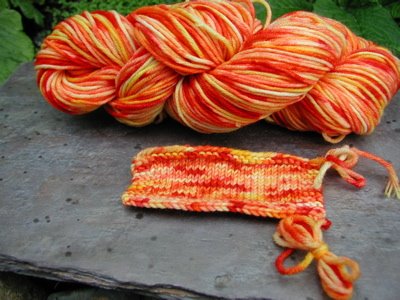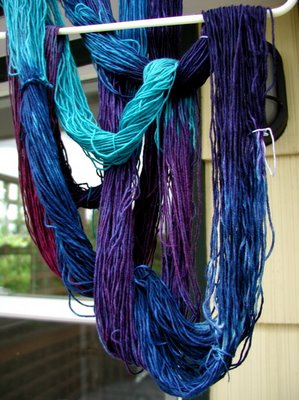I have done some dyeing, learning and blogging already. May 8th and May 8th, May 10th and May 17th.
All well and good. But I wanted more control. Time to get scientific.
The Math
First I made solutions of the seven colors, very
 carefully measuring 1 tsp of dye powder with 4 ounces of very hot water. 20 ounce VitaminWater bottles are sturdy with secure lids. Four ounces of water equals 24 teaspoons, so one teaspoon of my solution is about 1/25th tsp of dye powder.
carefully measuring 1 tsp of dye powder with 4 ounces of very hot water. 20 ounce VitaminWater bottles are sturdy with secure lids. Four ounces of water equals 24 teaspoons, so one teaspoon of my solution is about 1/25th tsp of dye powder.This method worked great, because the most dangerous and messy part is handling the fine powder. Once the solutions are made, they are pretty safe to deal with and last for a couple weeks.
The rule of thumb from the instructions is that 3 tsp of dye powder will turn one pound of fiber a dark shade.
So far I have been dyeing a pair of sock's worth of yarn, about 4+ ounces, a quarter pound of fiber. Round up a bit and it seems that 1 tsp of dye ought to suffice for a nice dark shade. That's 25 tsp of solution in whatever combination I can think of.
The Tests
Before having that fun, I made mini-skeins, each skein painted with two colors separately and blended, and blended with just a drop of black.

Six colors (not counting black) combine to make 15 colors. (Remember N Choose K? Good math lesson for the Nerd.) Another fifteen colors when a touch of black is added. Fifteen skeins of very useful information. Now I can more accurately get all those greens, purples, oranges and browns.
Very
 useful tools for this precision dyeing; a bunch of little medicine cups marked at the 1 and 2 teaspoon level, and a couple of medicine syringes -- very precise way of applying dye solution in measured amounts.
useful tools for this precision dyeing; a bunch of little medicine cups marked at the 1 and 2 teaspoon level, and a couple of medicine syringes -- very precise way of applying dye solution in measured amounts.Zach commented that the mini-skein with Fire Engine Red and Sunshine made a nice combination of orange. He thought a skein done in that mixture would be fun. But not so saturated.
Immersion Dyeing
Five ounces of sportweight merino in a skein 13 feet in circumference, carefully positioned in the dyepot to maximize variegation. I want red, Sunshine and Daffodil
 each individually and in combination. I also want one mixture of red and Sunshine to have just a drop or two of black. How much dye? Well, 25 tsp (of solution, from now on I always refer to solution) would make all the colors bright and saturated. The goal here was a bit more muted. I decided on 8 tsp total. All told, it has 3 tsp of red, 3 tsp of Sunshine and 2 tsp of Daffodil. Probably 3 drops of black. The blended colors were all blended before adding to the water, in my little medicine cups. Then each color was added to the water in semi-random pattern. The syringe was a great tool for this application, adding the different dye mixtures making sure to reach the yarn underneath evenly. Note the dark blotches. Those are dots of red injected in the water. They did not blend with the water at all and a sharp edge between the red and other colors is visible in the finished yarn. Unexpected, but interesting.
each individually and in combination. I also want one mixture of red and Sunshine to have just a drop or two of black. How much dye? Well, 25 tsp (of solution, from now on I always refer to solution) would make all the colors bright and saturated. The goal here was a bit more muted. I decided on 8 tsp total. All told, it has 3 tsp of red, 3 tsp of Sunshine and 2 tsp of Daffodil. Probably 3 drops of black. The blended colors were all blended before adding to the water, in my little medicine cups. Then each color was added to the water in semi-random pattern. The syringe was a great tool for this application, adding the different dye mixtures making sure to reach the yarn underneath evenly. Note the dark blotches. Those are dots of red injected in the water. They did not blend with the water at all and a sharp edge between the red and other colors is visible in the finished yarn. Unexpected, but interesting.
Zach declared the colorway a success, but of course he would never wear socks so bold. He thinks I should make myself socks. The colors will look like fire and my feet will feel warm. I think it looks more like ketchup and mustard artfully blended as if on a hot dog.
 Now to take advantage of the fact that my dye-pot will hold 8 glass jars. Again, five ounces of sportweight merino, 13 foot circumference skein. Colors desired are blues and purples, using Royal Blue, Turquoise, Fuschia and Black. Here I wanted dark bold colors, so a total of 24 tsps of dye solution. The yarn had presoaked in water and vinegar. I assembled the pot, jars and yarn, with water in the pot for simmering, the acidified soaking water divvied between the 8 jars. Three teaspoons of dye per jar, easy peasy no mess, I made a diagram to tell me which jars got which combinations of color, and used the little medicine cups to measure and pour. I did not premix the colors nor did I stir the liquid in the jars.
Now to take advantage of the fact that my dye-pot will hold 8 glass jars. Again, five ounces of sportweight merino, 13 foot circumference skein. Colors desired are blues and purples, using Royal Blue, Turquoise, Fuschia and Black. Here I wanted dark bold colors, so a total of 24 tsps of dye solution. The yarn had presoaked in water and vinegar. I assembled the pot, jars and yarn, with water in the pot for simmering, the acidified soaking water divvied between the 8 jars. Three teaspoons of dye per jar, easy peasy no mess, I made a diagram to tell me which jars got which combinations of color, and used the little medicine cups to measure and pour. I did not premix the colors nor did I stir the liquid in the jars.After about twenty minutes of simmering, I moved the yarn along a bit so that all had a
 chance in the dye. In this picture, you may be able to tell that most of the jars have clear water, all the dye absorbed. Turquoise however is quite stubborn and took longer to set. Thus confirming the reason for my previous issue with green and brown ending up yellow and red. I added a touch more vinegar to the jars with turquoise that hadn't been absorbed and let it simmer a little longer.
chance in the dye. In this picture, you may be able to tell that most of the jars have clear water, all the dye absorbed. Turquoise however is quite stubborn and took longer to set. Thus confirming the reason for my previous issue with green and brown ending up yellow and red. I added a touch more vinegar to the jars with turquoise that hadn't been absorbed and let it simmer a little longer.The final product is very much like what I intended. Can't wait to see it dried and skeined.


3 comments:
OMG, hot dog socks! You have to! They would be so great! I love it!
Do you happen to remember how Windows versions 95 and earlier had pre-set color schemes that you could set for your OS - and the worst one by far was called Hot Dog Stand. Red, orange, and yellow. I worked at an office where changing your Windows scheme to Hot Dog Stand was a common prank.
Your yarn is like the antidote to Hot Dog Stand!
I love the blue/purple/red one!
Very cool. All of it. You should go into business! Hand-dyed, hand-painted wool seems very lucrative here in Blogland!
Post a Comment